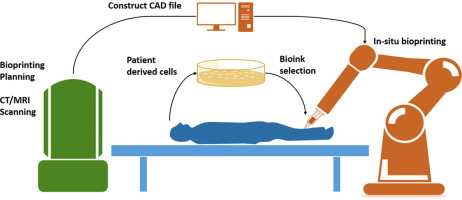当前位置:
X-MOL 学术
›
Acta Biomater.
›
论文详情
Our official English website, www.x-mol.net, welcomes your
feedback! (Note: you will need to create a separate account there.)
In situ bioprinting - Bioprinting from benchside to bedside?
Acta Biomaterialia ( IF 9.4 ) Pub Date : 2019-08-30 , DOI: 10.1016/j.actbio.2019.08.045 Satnam Singh 1 , Deepak Choudhury 1 , Fang Yu 1 , Vladimir Mironov 2 , May Win Naing 1
Acta Biomaterialia ( IF 9.4 ) Pub Date : 2019-08-30 , DOI: 10.1016/j.actbio.2019.08.045 Satnam Singh 1 , Deepak Choudhury 1 , Fang Yu 1 , Vladimir Mironov 2 , May Win Naing 1
Affiliation

|
Bioprinting technologies have been advancing at the convergence of automation, digitalization, and new tissue engineering (TE) approaches. In situ bioprinting may be favored during certain situations when compared with the conventional in vitro bioprinting when de novo tissues are to be printed directly on the intended anatomical location in the living body. To date, few attempts have been made to fabricate in situ tissues, which can be safely arrested and immobilized while printing in preclinical living models. In this review, we have explained the need and utility for in situ bioprinting with regard to the conventional bioprinting approach. The two main in situ bioprinting approaches, namely, robotic arm and handheld approaches, have been defined and differentiated. The various studies involving in situ fabrication of skin, bone, and cartilage tissues have been elucidated. Finally, we have also discussed the advantages, challenges, and the prospects in the field of in situ bioprinting modalities in line with parallel technological advancements. STATEMENT OF SIGNIFICANCE: In situ bioprinting may be favored during certain situations when compared with the conventional in vitro bioprinting when tissues are to be fabricated or repaired directly on the intended anatomical location in the living body, using the body as a bioreactor. However, the technology requires a lot more improvement to fabricate complex tissues in situ, which could eventually be possible through the multi-disciplinary innovations in tissue engineering. This review explains the need and utility and current approaches by handheld and robotic modes for in situ bioprinting. The latest studies involving in situ fabrication of skin, bone, and cartilage tissues have been elucidated. The review also covers the background studies, advantages, technical and ethical challenges, and possible suggestions for future improvements.
中文翻译:

原位生物打印-从台式到床头的生物打印?
随着自动化,数字化和新的组织工程(TE)方法的融合,生物打印技术一直在发展。与要从头开始将组织直接打印在活体预期解剖位置上的常规体外生物打印相比,在某些情况下可能更喜欢进行原位生物打印。迄今为止,几乎没有人尝试制造原位组织,在临床前的活体模型中打印时可以安全地将其固定和固定。在这篇综述中,我们已经解释了常规生物打印方法对原位生物打印的需求和实用性。已经定义并区分了两种主要的原位生物打印方法,即机械臂和手持方法。涉及皮肤,骨骼原位制造的各种研究,并且已经阐明了软骨组织。最后,我们还讨论了与并行技术进步相一致的原位生物打印方式领域的优势,挑战和前景。意义声明:与传统的体外生物打印相比,在某些情况下原位生物打印可能更受青睐,在传统的体外生物打印中,要使用人体作为生物反应器,直接在活体中预期的解剖位置上组织或修复组织。然而,该技术需要更多的改进以原位制造复杂的组织,这最终可能通过组织工程学中的多学科创新而成为可能。这篇评论解释了通过手持和自动模式进行原位生物打印的需求,实用性和当前方法。已经阐明了涉及皮肤,骨骼和软骨组织的原位制造的最新研究。审查还涵盖了背景研究,优势,技术和道德挑战以及未来改进的可能建议。
更新日期:2019-08-31
中文翻译:

原位生物打印-从台式到床头的生物打印?
随着自动化,数字化和新的组织工程(TE)方法的融合,生物打印技术一直在发展。与要从头开始将组织直接打印在活体预期解剖位置上的常规体外生物打印相比,在某些情况下可能更喜欢进行原位生物打印。迄今为止,几乎没有人尝试制造原位组织,在临床前的活体模型中打印时可以安全地将其固定和固定。在这篇综述中,我们已经解释了常规生物打印方法对原位生物打印的需求和实用性。已经定义并区分了两种主要的原位生物打印方法,即机械臂和手持方法。涉及皮肤,骨骼原位制造的各种研究,并且已经阐明了软骨组织。最后,我们还讨论了与并行技术进步相一致的原位生物打印方式领域的优势,挑战和前景。意义声明:与传统的体外生物打印相比,在某些情况下原位生物打印可能更受青睐,在传统的体外生物打印中,要使用人体作为生物反应器,直接在活体中预期的解剖位置上组织或修复组织。然而,该技术需要更多的改进以原位制造复杂的组织,这最终可能通过组织工程学中的多学科创新而成为可能。这篇评论解释了通过手持和自动模式进行原位生物打印的需求,实用性和当前方法。已经阐明了涉及皮肤,骨骼和软骨组织的原位制造的最新研究。审查还涵盖了背景研究,优势,技术和道德挑战以及未来改进的可能建议。





















































 京公网安备 11010802027423号
京公网安备 11010802027423号